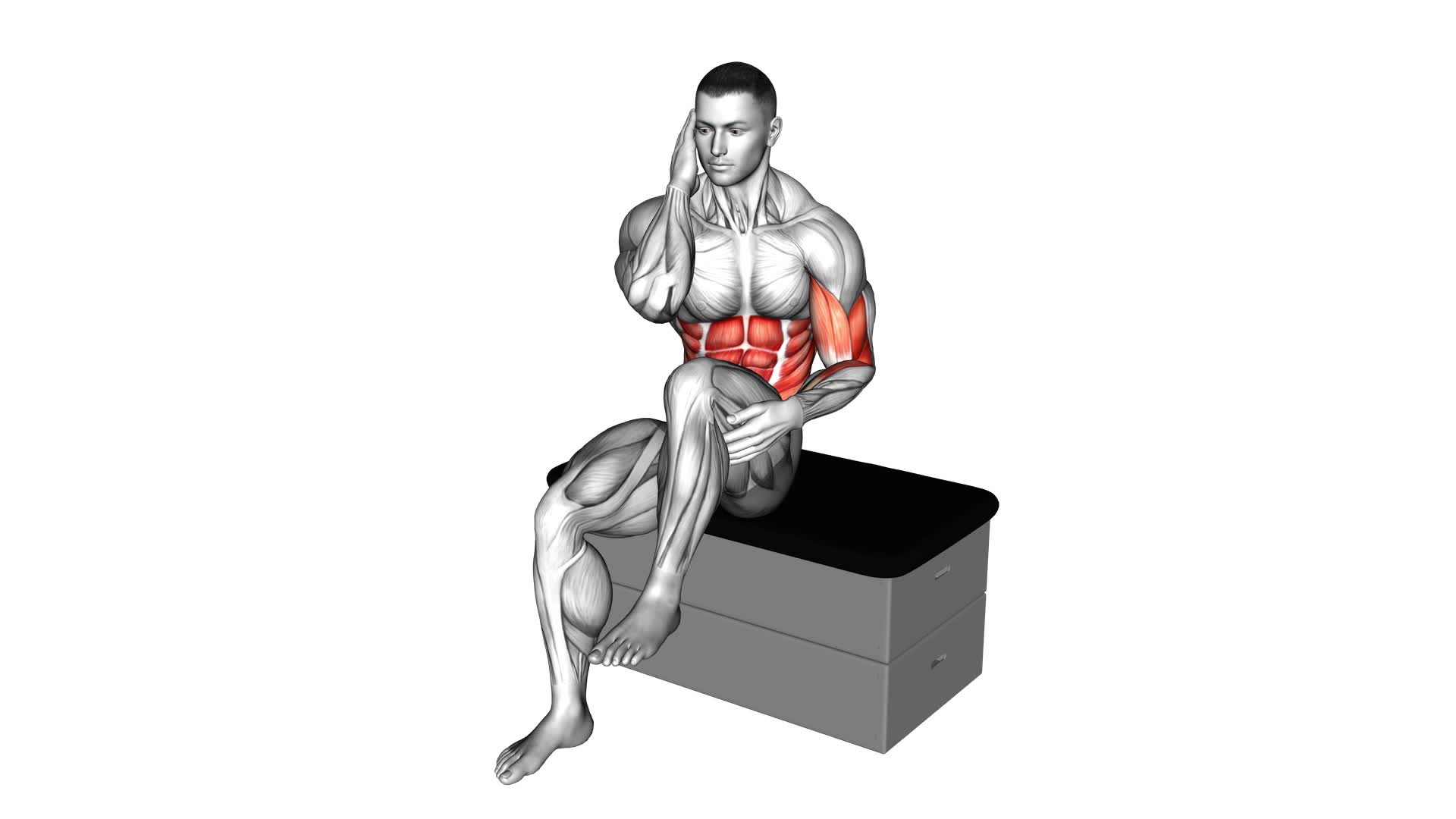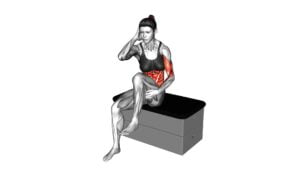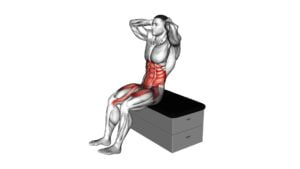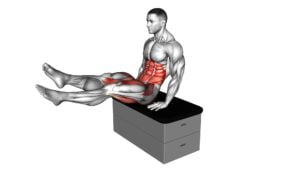Sitting Side Crunch on a Padded Stool – Video Exercise Guide & Tips

Are you looking for a new exercise to target your core muscles? Look no further than the Sitting Side Crunch on a Padded Stool!
Watch This Exercise Video
This video exercise guide and tips article will show you the proper form and technique, as well as modifications for different fitness levels. Avoid common mistakes and maximize your results with helpful tips.
Get ready to strengthen your abs and obliques with this effective seated exercise. Let's get started!
Key Takeaways
- Proper body alignment and form is essential for performing a sitting side crunch effectively and safely, including keeping the back straight, relaxing the shoulders, engaging the core, and avoiding swinging the body.
- The focus should be on activating the oblique muscles during the exercise, initiating the crunch with the obliques, engaging the side abdominal muscles, and squeezing the obliques throughout the movement.
- Core engagement is crucial for stability, maintaining proper form, supporting the spine, and enhancing overall strength, while reducing the risk of injury.
- Common mistakes to avoid during a sitting side crunch include swinging the body, relying on momentum instead of using the muscles, neglecting proper form, not engaging the oblique muscles, and allowing the shoulders to tense up.
Benefits of the Sitting Side Crunch
You will experience numerous benefits from incorporating the sitting side crunch into your workout routine. This exercise is especially beneficial for individuals who spend long hours sitting at a desk.
One of the main advantages of the sitting side crunch is its ability to strengthen your core muscles. The movement targets your obliques, which are the muscles on the sides of your abdomen, helping to tone and define them. Strengthening your core is crucial for maintaining good posture and preventing lower back pain, especially for desk-bound individuals who often suffer from poor posture.
In addition to core strengthening, the sitting side crunch also helps to improve your overall stability and balance. By engaging your core muscles, you develop a stronger foundation, which can enhance your performance in other exercises and daily activities. Furthermore, this exercise can help to increase your flexibility, as it requires a range of motion in the oblique muscles.
To ensure you reap the full benefits of the sitting side crunch, it's important to focus on proper form and technique.
Proper Form and Technique
To perform the sitting side crunch with proper form and technique, focus on engaging your core muscles and maintaining a stable position on the padded stool. Many people have common misconceptions about this exercise, thinking that it solely targets the oblique muscles. While the obliques are indeed engaged during the movement, the sitting side crunch also works the entire core, including the rectus abdominis and transverse abdominis muscles.
To execute the sitting side crunch correctly, sit on a padded stool with your feet flat on the ground and your knees bent at a 90-degree angle. Place your hands lightly behind your head, keeping your elbows wide. Begin the movement by contracting your obliques on one side, bringing your elbow and opposite knee together in a twisting motion. Return to the starting position and repeat on the other side. Throughout the exercise, make sure to keep your back straight and avoid using momentum to complete the movement.
Variations and progressions of the sitting side crunch can be incorporated to challenge your core muscles further. You can increase the intensity by holding a dumbbell or medicine ball while performing the exercise. Another option is to perform the movement on an unstable surface, such as a balance disc or a Bosu ball, to engage your core muscles even more.
Modifications for Different Fitness Levels
Different fitness levels can be accommodated with modifications to the sitting side crunch exercise. Whether you're a beginner or an advanced fitness enthusiast, here are some exercise variations and progression techniques to help you tailor this workout to your fitness level:
- Beginner Modifications: If you're new to the sitting side crunch, you can start by performing the exercise without any weights. Focus on mastering the form and technique before adding any additional challenges.
- Intermediate Variations: Once you're comfortable with the basic movement, you can progress by holding a dumbbell or a medicine ball against your chest. This added resistance will increase the intensity and engage your core muscles even more.
- Advanced Progressions: For those seeking a greater challenge, you can perform the sitting side crunch on an unstable surface, such as a BOSU ball or a balance cushion. This will require more core stabilization and enhance the effectiveness of the exercise.
- Core Integration: To further engage your core muscles, you can incorporate other exercises, such as planks or Russian twists, into your routine. These exercises will target different areas of your core and provide a well-rounded workout.
Common Mistakes to Avoid
As you progress in your sitting side crunch exercise, it's important to be aware of common mistakes to avoid, ensuring proper form and maximizing the effectiveness of the workout. By understanding these mistakes, you can make the necessary adjustments and modifications to prevent injury and achieve the desired results.
One common mistake is using momentum rather than engaging your core muscles. It's crucial to focus on controlled movements and avoid swinging your body during the exercise. This ensures that your oblique muscles are being targeted effectively.
Another mistake to avoid is neglecting proper posture. Maintain a straight back throughout the exercise, avoiding any rounding or arching of the spine. This helps to engage your core and prevent strain on your lower back.
Additionally, be mindful of your breathing. Many people hold their breath or exhale at the wrong time during the exercise. Remember to inhale as you prepare for the movement and exhale as you crunch to the side. This rhythmic breathing not only helps with the movement but also engages your core muscles more effectively.
Lastly, avoid relying solely on the stool for support. While the stool provides stability, it's important to engage your core muscles to maintain balance and control. This ensures that your abdominal muscles are being actively involved in the exercise.
Tips for Maximizing Results
To maximize your results in the sitting side crunch exercise, focus on proper form and engage your core muscles. Here are some tips to help you get the most out of this exercise:
- Gradually increase the intensity levels for the sitting side crunch. Start with a comfortable weight or resistance level and gradually increase it as your strength improves. This will ensure that you continue to challenge your muscles and see progress over time.
- Incorporate the sitting side crunch into a full body workout routine. This exercise primarily targets the oblique muscles, but you can make it more effective by combining it with other exercises that target different muscle groups. This will help you achieve a balanced and well-rounded workout.
- Pay attention to your breathing during the exercise. Exhale as you crunch to the side, and inhale as you return to the starting position. This will help you maintain control and engage your core muscles more effectively.
- Maintain proper form throughout the exercise. Keep your back straight, shoulders relaxed, and core engaged. Avoid using momentum or swinging your body to perform the movement. Focus on using your oblique muscles to initiate the crunch.
Frequently Asked Questions
How Long Should I Hold the Crunch Position During the Exercise?
To get the most out of the sitting side crunch exercise, focus on holding the crunch position for about 2-3 seconds. This will allow your muscles to engage and work effectively.
However, it's important to listen to your body and go at your own pace. If you're a beginner, you can modify the sitting side crunch by starting with smaller movements and gradually increasing the intensity.
Remember to avoid common mistakes like using momentum or straining your neck.
Can I Perform the Sitting Side Crunch on a Regular Chair Instead of a Padded Stool?
Yes, you can perform the sitting side crunch on a regular chair instead of a padded stool. It's important to find alternative equipment options that suit your needs.
While a padded stool provides additional support and comfort, a regular chair can still be effective for this exercise. Just make sure to maintain proper form and engage your core muscles throughout the movement.
Remember to consult with a fitness professional if you have any concerns or questions.
Is It Normal to Feel Some Discomfort or Soreness in the Oblique Muscles After Doing This Exercise?
Feeling discomfort or soreness in your oblique muscles after doing the sitting side crunch is normal. This exercise targets those muscles, so it's natural to experience some level of discomfort.
However, if the pain is severe or persists for a long time, it's important to listen to your body and modify the exercise or try different stretching techniques.
Remember to always start with a comfortable level of intensity and gradually increase as you get stronger.
Can I Incorporate Weights or Resistance Bands to Make the Sitting Side Crunch More Challenging?
To make the sitting side crunch more challenging, you can definitely incorporate weights or resistance bands. Adding weights will increase the resistance and intensity of the exercise, targeting your oblique muscles even more.
Resistance bands can provide a different type of resistance, helping to engage your muscles in a different way. Both options can help you progress and continue challenging yourself as you get stronger.
Remember to start with lighter weights or lighter resistance bands and gradually increase as you feel comfortable.
How Often Should I Include the Sitting Side Crunch in My Workout Routine for Optimal Results?
To get optimal results from the sitting side crunch, it's important to know how often to do it. Incorporating this exercise into your workout routine two to three times a week can be beneficial.
The sitting side crunch targets your obliques and helps strengthen your core. By consistently including this exercise in your routine, you can improve your abdominal strength and overall stability.
Remember to always listen to your body and adjust the frequency as needed.
Conclusion
In conclusion, the sitting side crunch on a padded stool is a highly effective exercise for targeting the oblique muscles and improving core strength.
By maintaining proper form and technique, individuals can maximize the benefits of this exercise.
It's important to modify the exercise according to fitness levels and avoid common mistakes for optimal results.
Incorporating these tips into your workout routine will help you achieve your fitness goals efficiently and effectively.

Author
Years ago, the spark of my life’s passion ignited in my mind the moment I stepped into the local gym for the first time. The inaugural bead of perspiration, the initial endeavor, the very first surge of endorphins, and a sense of pride that washed over me post-workout marked the beginning of my deep-seated interest in strength sports, fitness, and sports nutrition. This very curiosity blossomed rapidly into a profound fascination, propelling me to earn a Master’s degree in Physical Education from the Academy of Physical Education in Krakow, followed by a Sports Manager diploma from the Jagiellonian University. My journey of growth led me to gain more specialized qualifications, such as being a certified personal trainer with a focus on sports dietetics, a lifeguard, and an instructor for wellness and corrective gymnastics. Theoretical knowledge paired seamlessly with practical experience, reinforcing my belief that the transformation of individuals under my guidance was also a reflection of my personal growth. This belief holds true even today. Each day, I strive to push the boundaries and explore new realms. These realms gently elevate me to greater heights. The unique combination of passion for my field and the continuous quest for growth fuels my drive to break new ground.







